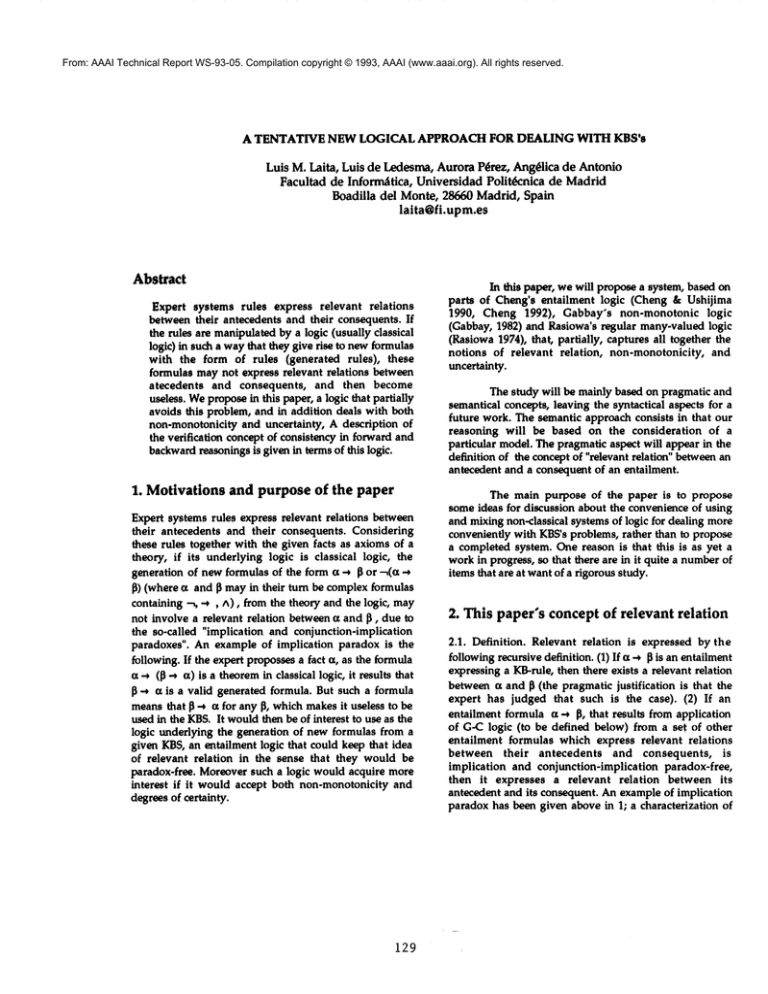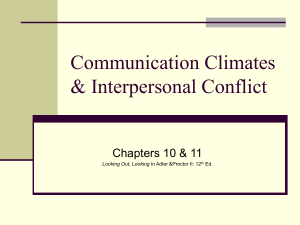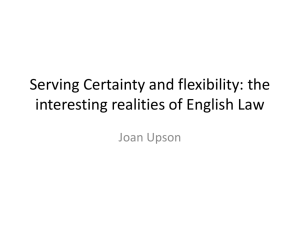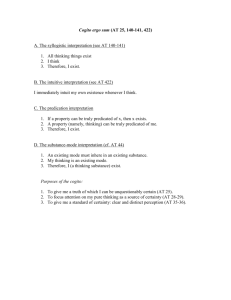A TENTATIVE NEW LOGICAL APPROACH FOR ... Luis M. Laita, Luis de Ledesma, ...
advertisement

From: AAAI Technical Report WS-93-05. Compilation copyright © 1993, AAAI (www.aaai.org). All rights reserved.
A TENTATIVE
NEW LOGICAL APPROACH FOR DEALING WITH KBS’e
Luis M. Laita, Luis de Ledesma, Aurora P~rez, Ang~Hca de Antonio
Facultad de lnformaitica,
Universidad Polit~cnica de Madrid
Boadilla del Monte, 28660 Madrid, Spain
laita@fi.upm.es
Abstract
Expert systems rules express relevant relations
between their antecedents and their consequents. If
the rules are manipulated by a logic (usually classical
logic) in such a waythat they give rise to newformulas
with the form of rules (generated rules), these
formulas may not express relevant relations between
atecedents
and consequents,
and then become
useless. Wepropose in this paper, a logic that partially
avoids this problem, and in addition deals with both
non-monotonicity and uncertainty, A description of
the verification concept of consistency in forward and
backwardreasonings is given in terms of this logic.
1. Motivations and purpose of the paper
Expert systems rules express relevant relations between
their antecedents and their consequents. Considering
these rules together with the given facts as axioms of a
theory, if its underlying logic is classical logic, the
generation of new formulas of the form a ~ 13 or ~(a --,
[3) (where a and [3 may in their turn be complex formulas
containing --b -~ , ^), from the theory and the logic, may
not involve a relevant relation between a and 13, due to
the so-called "implication and conjunction-implication
paradoxes". An example of implication paradox is the
following. If the expert proposses a fact a, as the formula
a ~ (13 --* a) is a theoremin classical logic, it results that
13 ~ a is a valid generated formula. But such a formula
meansthat 13 --, a for any 13, whichmakesit useless to be
used in the KBS.It would then be of interest to use as the
logic underlying the generation of new formulas from a
given KBS,an entailment logic that could keep that idea
of relevant relation in the sense that they would be
paradox-free. Moreover such a logic would acquire more
interest if it would accept both non-monotonicity and
degrees of certainty.
129
In this paper, we will propose a system, based on
parts of Cheng’s entailment logic (Cheng & Ushijima
1990, Chang 1992), Gabbay’s non-monotonic logic
(Gabbay, 1982) and Rasiowa’s regular many-valued logic
(Rasiowa 1974), that, partially, captures all together the
notions of relevant relation,
non-monotonicity, and
uncertainty.
The study will be mainly based on pragmatic and
semantical concepts, leaving the syntactical aspects for a
future work. The semantic approach consists in that our
reasoning will be based on the consideration
of a
particular model. The pragmatic aspect will appear in the
definition of the concept of "relevant relation" betweenan
antecedent and a consequent of an entailment.
The main purpose of the paper is to propose
some ideas for discussion about the convenience of using
and mixing non-classical systems of logic for dealing more
conveniently with KBS’s problems, rather than to propose
a completed system. One reason is that this is as yet a
work in progress, so that there are in it quite a numberof
items that are at want of a rigorous study.
2. This paper’s concept of relevant relation
2.1. Definition. Relevant relation is expressed by the
following recursive definition. (1) If a ~ 13 is an entailment
expressing a KB-rule, then there exists a relevant relation
between ct and [3 (the pragmatic justification is that the
expert has judged that such is the case). (2) If
entailment
formula
a-,[~,thatresults
fromapplication
of G-C logic(to be definedbelow)froma set of other
entailment
formulaswhichexpressrelevantrelations
between their antecedents and consequents,is
implication
and conjunction-implication
paradox-free,
then it expressesa relevantrelationbetweenits
antecedent
anditsconsequent.
An example
of implication
paradox
hasbeengivenabovein I; a characterization
of
conjunction-implication paradox will be given in terms of
the modelin 5.
2.2. Remark.This concept of relevant relation is a limited
one, but at least it avoids the manycases of irrelevance
that are produced by the mentioned paradoxes.
3. Cheng’s approach to implication
paradox-freelogic
4. An approach to non-monotonicity
4.1. Outline.
Cabbay defines a forming formulas operator G which in a
few words may be described as follows. Ca is asessed to
be true at a time t ff it is accepted at t that at somefuture
moments > t it will be knownthat a was true at t (it has
previously
been defined an order relation
among
moments of time). Such an asessment is based on the
usual behaviour of the universe to which the system refers
to and no evidence on the contrary.
G embodies an
increment of knowledge, not the occurrence of new
events.
Non-monotonicity appears when, given a set of
formulas hypotheses, an expert adds a formula of the
form Ga to that set, in order to find some condussion. But
if somenewhypothesis is added to the first mentioned set,
the expert may now judge convenient to change Get by,
say, GI~, so that the conclusion previously found does not
hold any more and it should be changed by another one.
3. 1. Outline
Axioms
l.(a -, (13 .4 y)) .4 ((p .4 (a
2. (p -,, ~) .4 ((a .4 13).4 (a -,,
3.0"* O,
4. a^p .4 13^a,
5.(a-*
I~)^(a~y)-’*
p -* a for any a, and conjunction-implication paradoxes
as (a .4 [3) .4 (aA 7.4 ~) are not allowed in our version
Cheng’s calculus.
(a.4
7. (--a.4 13)-. (--~.4
8. a ^-~p.4 --,(a .4 13)
Inference rules
1. ModusPonens, "from a, a .4 [3, infer I~".
2. And-introduction, "from a and [3, infer a ^ 1~"
The primitive connectives in this calculus are .4, ^, and
~. A special disjunction is defined: "a v ~ iff ~a .4 [3 ":
note that by axiom7, a v 13 -~ [3 v a.
5. G-Clogic
5.1. Introduction.
3.2.OuruseofCheng’s calculus.
3.2.1. Language.
In addition to the propositional variables, let us introduce
three constant propositions F (absolute falsity),
(conjunction-irrelevance), and T (absolute truth).
3.2.2. Axioms.
The same as above with the following addenda or
changes.
-Add as axioms 1’. ~(F-~CI), 1". ~(CI--+F), 1’". a .4
-Delete axioms I and 4.
-Change axiom 7 by the axiom, (a ~ [3) .4 (~[3 .4 -sot).
3.2.3.
Rules.
Changerule2 by therule,"from(F ~ a ) and(F
ifaand[3, infer a^[3andF.4 ~p"
-Addrule,
"from
a ^ [3,infer
[3^ cx".
Wesuggest trying a logic consisting of:
(i) The axioms and inference rules of Cheng’s
calculus, modified with the changes and addenda in 3.2.
(ii) The Gabbay’s two logic axioms a ~ Get, and
GGa .4 Got,
(iii) An axiom ~Got .4 --~.
(iii) a v 13 is defined as --ax .4
We will call this logic "G-C" logic ((3 and
respectively stand for (3abbay’s operator and for Cheng’s
calculus) KBS’sexpressed in terms of this logic will be
called "G-C-KBS’s".
5.2 Interpretation of G-Clogic.
3.3. The generation of paradox-free entailments in this
calculus.
Wewill see by using the model of section, that implication
paradoxes as a .4 ([3 .4 a) that allows, given a, finding
130
5.2.1. Definition. An entailment-preorder (e-p) L consists
of a meet semilattice L1 with eight vertices together with a
five elements meet semilattice L2, L1 and L2 having four
commonelements as described in 5.2.2. below. Three
operators N, E, (3, three distinguished elements F, CI, and
T, and two distinguished subsets Tt and Ff of L, are added,
satisfying the following conditions.
(3) Gis definedasfollows:if Ca= 60thena = 60,if Ca= 20,
thena =20or 10, if Ca= 10,thena = 10, if Ca= 30thena =
30or 10.
(7) Definitionof E.
(0) Wedefine separatedly in L1and 1.,2 a preorderrelation
"a < b iff a divides b". Wealso define separatedly in L1
and L2, "&Lb.(a, b) = a ^ b = g.c.d (a,b)". Note
considering L as a whole, not all pairs of elements will
have a meet.
(1) Nis a mapping
N: L-~L that satisfies for all a, b E
(i) Na~t
(ii) < NN
a,
(iii) if a < b, then Nb~ Na.
(2) Tt is distinguished subset ofL, of "true values" that
satisfies:
(t) for all ae L, a ~ Ttiff Na¢~Tt,
(ii) for all a,b ~ L, a ^ b e Tt iff a e Tt andb ETt,
(iii) there exists no a, b e L such that a ~ Tt,
NbGTt and a <b.
(3) E is a mapping
L x L-->L that satisfies for all a. b. c
[;
(i) E(a,b)e Tt iff < b,in particular, E(a,a) ~ T
(ii) ECo,c)
< E(E(a,b),E(a,c)),
(iii) E(a,b)^ E(a,c)~E(a,b3
(iv) E(a,b) < E(Nb,Na),
(v) E(a, NNa)
(vii) E(a^Nb,NE(a,b))
(The arrow corresponding to E will herafter be
called "G-C-entailment")
(4) G is a mapping
L-* L that satisfies,
E
2
4
6
12
10
20
30
60
3
(ii) E(a, Ga)e Tt for all
(iii) NGa-->
5. 2.2. Anexample.Considerthe particular p-e of figure 1.
30
60 3
60 2
60 2
60 2
60 2
60 2
60 2
60 2
60 2
60 30
logic.
5.4. Atotal order relation can be defined amongthe labels
of the vertices of the lattice: the total order providedby the
indexesi = 0, 1, ..., 5, of the ei consideredas a total order
of certainty degrees. Theei are definedas as follows: e0 =
2or3, eI =4or6, e2=12, e3 =10, e4ffi20or30, esffi60.
Statementsas e0 =2 or 3, meanthat 2 and 3 indiferently
indicate a sametruth value, so that if an expert proposes3
as somecertainty degree, and for practical purposes is
moreconvenientto take 2 instead, it is allowedto do so.
3
4
30
60
2
3O
2
30
2
30
2
30
5.3. Interpretation..
Aninterpretation I of G-Clogic is the p-e L described
along this paragraph together with a mappingVa:{simple
propositions}~ L, and a mappingvf: {formulas}-* L which
satisfies for all simplepropositionAand all formulasB, C,
(i) vf(A)= va(A),vf(-~B)= Nvf(B),vf(B^ C) = vf(B)
vf(B--. C) = E(vf(B), vf(C)). I mapsformulasinto
of L whichare in Tt or not. Wedenote I(A)=tiff in L,
Tt, I(A)=f iff Ac_Ff. I(A) = means that A isnotalways
able to forma conjunction.AformulaA is valid in L iff I(A)
= t. All axiomsof G-Clogic are valid in L. If the premisesof
the inference rules are valid, the conclussions are also
valid.
Notethat as for instance12 < (4 < 12) has value 2,
the implicationparadoxct --~ (13 --~ ct) is not valid in this
logic. Also, (20~60), but it is not the case that 3A20~
because3^20doesnot exist, thus if cx -b [3, then ¢z^y-~
is not valid. Then the implication and conjunctionimplication morefrequent paradoxesare not valid in this
(i) GaCC
a
60
2 4 6 12 10 20
60 60 60 60 60 60
220
220
2 20
223030
2
2
2 2 2 10 2
2
2 4 6 12 10 20
2 4 2 4 2 20
2 2 6 6
2
2
2 2 2 2
2
2
2 2 30 30 2
2
2
Figure 1
6. Expression of G-C-KBS’s
(1) Theverticesare labeled2, 4, 6, 12, 10, 20, 30, 60, 3. { 2,
6, 12}is the set Ff of falsevalues,.{10,20, 30, 60}is the set Tt
of true valuess. 3 is the representationof CI, 2 that of F,
and 60 that of T. The role of 3 is to indicate the non
existenceof cx A3, for ct E{2, 4, 10, 20}.
(2) N is definedas follows. N2= 60, N4= 20, N6= 30, N12
10, N10= 12, N20= 4, N30= 6, N60= 2, N3= 30.
_
131
6.1. Literals. Aliteral is any propositionappearingin the
KBS’srules precededor not by --1. A G-literal is a literal
preceded by the symbolG.
J
6.2. KBSbases of facts. Weconsider two different sets of
facts: a set of established knownnow to hold with total
certainty (which is defined as having value 60) facts, and
set of assoc/at¢ facts, of the form Ga that should be added
to the set of the established facts on which grounds those
Gix’s are supposed to hold.
The associated facts should be given a certainty
valuein {10, 20, 30, 6O}in the list e0 ..... e5
For instance, facts can be (8) Flight AA740with
destination Chicago left NewYork at 5 A.M.", (~)"No plain
can land in Chicago because of athmosferic
bad
conditions", (£) "Radio message sent at 7:02 A.M. to pilot
of AA740informing of fact 13"
An example of associated fact to those four facts
is (according to some accepted policy of the Company),
(Gixl) "The airplain will be deviated to a close to Chicago
safe airport"(certainty {30, 6O}).
Established facts are literals, associated facts are
G-literals.
We thus take as a convention the following
definition of set of facts.
6.3. Definition. A set of facts is (in addition to the usual
requirements in KBS’s, as for instance being the IF
conditions of rules which are not THENconditions) a set
of established facts together with all the facts which are
associated
to alltheconjunctions
of themembers
of that
set(there
maybedifferent
associated
facts
to,say,ix^ [3
thanto ix andJ3 alone).
Theassociated
factsshouldbe
assigned
a range
ofcertainty
in{I0,20,30,60}.
6.4. Remark.In order to justify our definition of rule to be
given below, let us simulate the process that an expert
would pursue in order to write a KBSrule having G-C
logic as its underlyinglogic.
(i) The expert chooses as premises someliterals which
considers are now absolutely true as for example 8,13, e
of the examplein 6.2.
(ii) The expert proposes someG-literals as GixI which are
associated facts to the conjunction of the litsrals of (i).
then proposes the conjunction of the mentioned literals
and G-literais, in our example 8 ^ 13 a e ^ Gixl, as the
antecedent of the rule. He also assigns to Gix1 a linearly
ordered certainty range in {10, 20, 30, 60}, as for instance,
{30.601.
v0ii) The expert proposes a disjunction of literals, as ~1
132 as the consequent of the rule. The disjuncts are written
from left to right according to some criterium of
precedence. In the example, 131 is judged more likely to
be the consequence than [32. Let for instance 131 be
"AA740will land at South Bend" and 132 "AA740will land at
Kalamazoo".
132
(iv) ~1 is given a certainty range that must include the
range given to Gctl, and [32 is given a certainty range that
must include the certainty range of ~1.
(v) In order to showthe possibility of non-monotonicity,
suppose that in addition to 8 ^ ~ ^ e, we knowat 7:15 (q)):
"there is an extense high wind area between NewYork
and Chicago that makes the planes with destination
Chicago fly around New York and wait". We may now
have as associated fact to 8 a 13 ^ e ^ ¢p, (Get2) "The
AA740flight is still at 7:50 both not far from NewYork and
short of fuel" (range of certainty {30, 60}). Then, according
to some Policy of the company, the rule maybe now:
6^ p ^ ~^ ~p^ Ga2-, 133,
where 133 is now "AA740returning to NewYork".
These considerations
lead to the following
definition of rule.
6.5. Rules. A rule is a G-C entailment between a
conjunction of literals and G-literals and a disjunction of
literais. Eachconjunction of literals in the left side of the
implication must be accompanied by all the G-literals
which are associate to the Conjunction. The literais in the
disjunction must be given by the expert or KB-builder a
precedence order: if ~1 appears written at the left side of
~2, it means that [51 is considered by the expert more
likely to be the conclussion of the rule than, 132, even
though 132 ought to be taken under consideration for the
case that [31 does not hold. Accordingly, a rule is a G-C
logic entailment of the form:
ixll ^ ixl2 ...^ ixlm ^ Gix21^...^ Gix2q’~ ix31 v
ix32 ...v ix3s
where Gix2i (i=1 ..... q) are the associated fact to the
conjunction
all ^ ixl2 ...^ ixlm,and ix31 v ix32
...v ix3s is a G-Clogic disjunction of literals that have
given an order of precedence by writting them from left to
right in the disjunction. The literals ixll, ixl2 ..... ixlm,
ix31 ..... ix3s, may be preceded by the symbol of
negation. Moreover,the expert assigns to each G-literal in
the premise a range of certainty beginning at some value
ei. Ontheir turn, ix31 is given a certainty range that must
include the range given to G-literal having the largest
range (that is less certainty) ix32 is given a certainty range
that must include the certainty range of ix31. and so on.
7. Treatmentof uncertainty
7.1. Introduction.
KBS’s expressed in the proposed G-C logic language
would be difficult
to manipulate because too many
aspects (a special disjunction, associate facts, mutiple
values, etc) ought to be considered. Nevertheless there is
a way to simplify this manipulation by using Rasiowa’s
regular logic, which allows manipulating multiple
certainty degrees by using bivalued logic techniques.
overtheindexes
0,1.....
5 insucha waythat/A/=
i iffv(A)
= ei.Forinstance,
v(A)
= I0iffIA/=
Applyingto the indexes 0, 1, 2, ..., 5 the operators
c,’s one obtains:
7.2. Regular many-valuedlogic
/M
0
ol(A ) F
c-2(A)
o3(A)
c,4(A)
c-5(A)
7.2.1. Description.
Let us consider a chain of certainty degrees, eO,
el, e2,...,em.1, with ei < ej for i < J. Rasiowasuggested a
simplification of the use of multiple values in formulas by
defining unary-connectives oi (i=1,...,m-1) which assign
truth values in (F, T} as follows. Let/a/be the certainty
degree (one of the ei’s above) of a formula a. oi(a) =
/a/> el, and oi(a) ffi F otherwise. In this context a regular
many-valued logic is a system which in addition to the
axiom schemas of classical bivalued logic, it includes the
following axiom schemas (the index i varies from 1 to m-l)
(M1) c,i(a v [}) ~ c’i(a)v oi([})
(M2) c’i(a ^ [}) 4"-~i(a)^ c,i([~),
0U3) c,i(a-, [}) ~ ^jfl...i(c,j(a)-b c’j([})),
(M4) c,ic,j(a) ~ c,j(a),
(M5) Om-1 (a)-+
(M6) c,i(a)~ oj(a)
(M7) c, l (a)v~c,l (a),
(M8)
(c-i(^)--+
c,j([}))~
((c’j([})-*
¥)-*
¥)),
(M9)c’i(a)~
c-i(a)vc’j([}),
(Ml0)(oi(a)-*
c,k(’/))--,
((c,j([})~
c,k(7))-~
(c’i(a)vc,j([})~
(MII) c,i(a)^ c,j([})--+ oi
(MI2)c-i(^)^ c,j([})-.* c,j([}),
(M13)(akff) -* c,i(a))-~
~ ai(a)^
((c’k(7)
~ c,j([}))’-+
(c’k(7)
c,i([}))),
(Ml4)(c’i(a)~
(c,j([})~
((c’i(a)^c,j([}))--,
c-kC/)),
(Ml5)(c,i(a)^oj([})~
7)~
(c-i(^)-*
(c,j([})=~
c-k(’/))),
(MI6) c,i(a)A --~i(a)-+ c,j([}),
(MIT) c,i(a)-~ (c,i(a)^ -~i(a)-*
(MIg) a.-, c,l(a),
(MI9)c,i(a)-* oj([})vc-i(a),
(M20)~c,i(a) ¢-+Om-i(~a).
The inference rule is ModusPonens.
Suppose
we havethe sequence
of the p-e labels
(seeS.2.2),e0
=2or3,el =4or6,e2=12,e3=10,e4=20
or 30,e5 = 60.
Let A be any literal or G-literal. Let us denote by
v(A) the p-e label assigned to A. We make/A/ range
133
1
T
F
F
F
P
2
T
T
F
F
F
3
T
T
T
F
F
4
T
T
T
T
F
5
T
T
T
T
T
The consideration
of the table for the given
example (for any other sequence the argument is similar)
suggests the following interpretation
of the results of
application of operators c-i’s to formulas, c-m-1 makes
true the literals or G-literals A such that v(A) is exactly
(/A/.= 5), o3 makes true any formula A such that v(A)
{e3, e4, e5} (/a/¯ (3 ..... 5}) ..... in general c,i makestrue
the liter^Is or G-literals A such thatv(A) > ei (that is
IA/~ i).Then c,i(A ) is a measure of the range of certainty
of A because to state that c,i(A) is true meansthat A has
certainty degree ranging over the set {ei ..... e5}. On the
other hand,stating for instance thatv(A) is exactly i
(/A/ = i), it means that both formulas in the pair
(c,i (A),~C-i+I(A)) are true; v(A) = e0 (/M ffi
--~oI(A) is true.
7.2.3. Facts.
In this context, to state for instance that an associated fact
G8 is given a certainty value v(Gg) = 10 (e3), means
having c’3(G6) and ~ C,4(G6). We agree in giving (nonassociate) facts the p-e value 60.
7,2.4. Rules.
Similarly to it has been explained for facts, G-C- rules
must be changed into c,i-expressions.
For the sake of
1simplicity we work with the rule in 6.4 8 ^ [} ^ g ^ Ga
"+ [}1 v [}2 which, by definition of the connective v,
results in:
8 ^ [} ^ ~ ^ Gal~ (’~[}1"* [}2).
Now,let{30,60}bethecertainty
rangeforGal,letalso
{30,60}and{10,30,60}respectively
bethecertainty
ranges
of [31 and [}2.
The final reformulation of the rule above has then the
form 8 ^ [} ^ e ^ c,4 Gal-~ (c’4~[}1 -* c,3[}2), which
a formula of classical bivalued logic Wecan apply to this
formula the axiom of classical bivalued logic (a ^ b ~
) ~-~ (a -~ (b -~ g ), obtaining as a final result the rule:
6 A [} A £ A c-4 Gala"~4[}1 " c’3[}2
If the ruleshavemorethantwo disjuncts,
the
sameprocessmustbe applied.We obtainthen a set of
rules of bivalued classical logic, subject to the axioms MI
to M20above, and with just one consequent.
8. Forwardreasoning inconsistency
Once the transformations described in 7 for both
facts and rules have been performed, one has both the
base of facts and the KBtransformed into ai-expressions.
These can be now manipulated using Modus Ponens as
for bivalued logics. If trough this manipulation, the pair
(~i(a), -~j(a)) for i ~] is found, a contradiction (better
said, a conflict) exists. For instance, for m--6, to state cr2(a
)
meansthat v(a) ranges over the set {e2, 3, e4, e s}, a nd t o
state, say, ~a2(a), that is o6_2(~a), means that v(~a)
ranges over the set {e4, es}; this embodies an overlapping
of values for v(a) and v(--ct); in other words, a and
are being assigned some commonvalues in the model.
Other conflicts may arise from constraints as
declaring oi (a) and oj ([3) to be incompatible.
It has to be remarkeed that, by using G-C logic,
we have in addition to the given KB rules, a set of
generated rules, which "have sense" because they keep
expressing relevant relations between the literals that
appear in the original
KB set of rules.
All the
transformations described in 7 should be applied to both
the set of given KBrules and the set of generated rules,
and consistency refers to the union of both sets.
Applying forward reasoning to the set of given and
generated rules is a larger process than the mere
application to just the given rules. Nevertheless such a
process may bring to light inconsistencies that migh be
hidden in the ordinary process.
There is also a theoretical advantage when dealing with
the augmentedset of rules, that consists in the possibility
of constructing
more propoer algebraic models for
Verification than those arising from the consideration of
just the set of given rules.
9. Backwardardreasoning inconsistency
(vi) Backwardreasoningconflict for a given set of facts is a
question
of inadequacy rather
than of logical
inconsistency. It consists in that, once a goal q and a set F
of facts expressed as oi -formulas, the conjunction of
which is p, are proposed, at least one of the next two
conditions hold; (1) the goal is not reachable by forward
reasoning from the facts in F , (2) the following two
conditions hold simultaneously: (2-1) p -* a for any
formula or oi -formula a formed using the language that
has as predicates just but all the predicate symbols
appearing in the KB,(2-1) for all formula or oi -formula
of the language mentioned in (2-1), [3 ~ q holds. The two
conditions in (2) imply that q is reachable from F through
134
any sequence of implications starting in the conjunction
of the elements of F. So, backward reasoning conflict
means that q can be reached from F following conflicting
paths in the sense that there are at least two chains of
implications beginning in the conjunction of the elements
of F and ending in q, such that an arrow in the first chain
has a formula a as antecedent or consequent of the
implication and another implication in the second chain
has -~ also as antecedent or consequent. This is similar to
proving some mathematical theorem by means of proofs
that contradict each other.
Acknowledgements.
This work is supported by the Spanish Comission for
Science and Technology CICYT
References
Cheng,J., Ushijima, K., 1990. Nonmonotonic Reasoning
Based on Entailment Logic., in Proc. Fourth International
Symposium in Knowledge Engineering,
pp 192-198,
Barcelona.
Cheng, J., Ushijima, K.,1992. Conditional Relation Calculus
as the Logical Basis of Reasoning Rule Generation in
Knowledge Based Systems, in Proc. Fifth International
Symposium in Knowledge Engineering,
pp 313-320,
ScviUa.
Gabbay, D. M., 1982. Intuitionistic basis for non monotonic
logic, in Proc. ConL on AutomatedDeduction, Springer
Lecture Notes in ComputerScience. Vol 138, 260-273.
Rasiowa, H., 1974.. Analgebraic approach to non-classical
logics. Stud/es in Logic and the Foundations of
Mathematics, vol. 78, North Holland



